Graziani F. (editor) Computational Methods in Transport
Подождите немного. Документ загружается.


High Order Schemes for BTE 407
1
v
∂
¯
ψ
ijk
∂t
(Ω,t)+
1
∆r
ijk
Z
ijk
Ω ·∇ψ(r, Ω, t)dr +¯σ
ijk
¯
ψ
ijk
(Ω,t)
=
∞
n=0
¯σ
ijk
s,n
n
m=−n
¯
φ
m
n,ijk
(t)Y
m
n
(Ω)+¯q
ijk
(Ω,t) ,
(11)
where the quantities marked with a bar are “cell-averaged” (in essence inte-
gral) quantities, and not point values. In particular:
¯
ψ
i,j,k
(Ω,t)=
1
∆r
ijk
Z
ijk
ψ(r, Ω, t)dr ,
¯
φ
i,j,k
(t)=
1
∆r
ijk
Z
ijk
φ(r, t)dr ,
¯q
i,j,k
(Ω,t)=
1
∆r
ijk
Z
ijk
q(r, Ω, t)dr ,
(12)
For the first integral in (11), use Green’s Theorem to obtain
1
∆r
ijk
Z
ijk
Ω ·∇ψ(r, Ω, t)dr =
µ
∆x
i
(
¯
ψ
i+
1
2
,j,k
−
¯
ψ
i−
1
2
,j,k
)
+
η
∆y
j
(
¯
ψ
i,j+
1
2
,k
−
¯
ψ
i,j−
1
2
,k
)
+
ξ
∆z
k
(
¯
ψ
i,j,k+
1
2
−
¯
ψ
i,j,k−
1
2
) . (13)
The averaged values with half-indexed subscripts now denote face values over
each respective cell face. These too are averaged values, but over faces instead
of cells:
¯
ψ
i+
1
2
,j,k
=
1
∆y
j
∆z
k
y
j+
1
2
y
j−
1
2
z
k+
1
2
z
k−
1
2
ψ(x
i+
1
2
,y,z,Ω,t) dy dz , (14)
and similarly for the other face values.
Note that with the substitution of (13) into (11) we have both cell-
averaged and face-averaged quantities. To close the system, we express the
face values in terms of the cell averages, often called the reconstruction pro-
cedure in the literature. This is the step where the spatial accuracy is deter-
mined in any finite volume scheme. For example, if we simply take
¯
ψ
i+
1
2
,j,k
=
¯
ψ
i,j,k
, if µ>0
¯
ψ
i+1,j,k
, if µ<0
(15)
we get the simple upwind, or “step” method. By replacing the face value by
the average of the cell values on each side of the face we arrive at the diamond
difference approximation:

408 B.L. Bihari and P.N. Brown
¯
ψ
i+
1
2
,j,k
=
1
2
¯
ψ
i,j,k
+
¯
ψ
i+1,j,k
(16)
If the interpolation scheme that relates the face- and cell-averages to each
other is higher order, the spatial accuracy will be (at least formally) higher
order as well. With linear interpolation schemes, however, oscillations will oc-
cur near discontinuities in the solution, in the source term, or in the material
interfaces, or even at smooth, but steep gradients in the solution.
The WENO (“Weighted Essentially Nonoscillatory”) method is in fact
an interpolation scheme where the weights used in the linear combination
of the interpolation points vary with the size of the derivative. The larger
the gradient is near an interpolation point, the smaller the weight will be for
that point. The idea goes back to the TVD (Total Variation Diminishing)
method [Har83] which eliminated oscillations by choosing the left or right bi-
ased slope for reconstruction. The ENO (Essentially Nonoscillatory) [Har87]
scheme raised the inherently second order accuracy of the TVD scheme by
relaxing the TVD property to “essentially nonoscillatory” and choosing the
interpolation stencil matching the order of accuracy from a set of available
ones. With ENO the oscillations are not completely ruled out, but their size
is reduced from O(1) to O(h
r
), where r is the order of accuracy. That is, in
essence, oscillations were eliminated. The WENO scheme improved on this
concept by not choosing, but rather, weighting the stencils by their smooth-
ness [Shu97] .
3.3 The Weighted Essentially Nonoscillatory Interpolation
In this section we give a brief overview of the specific WENO method used in
the numerical experiments. The formulae come mostly from [Shu97], but for
completeness we include them here. For clarity, we present the 1-D version
of the interpolation, which can be readily used in a direction-by-direction
fashion to reconstruct all three spatial dimensions in (13).
Given a cell averaged grid function {¯v
j
}
N
j=1
on a set of grid cells {x
j
}
corresponding to a grid {x
j−
1
2
}
J
j=1
, we approximate v
j+
1
2
at the cell faces via
a weighted linear combination of all possible interpolations:
v
j+
1
2
=
k−1
r=0
w
r
v
(r)
j+
1
2
where typically k = 2 (for WENO3) or k = 3 (for WENO5). The v
(r)
j+
1
2
are
the various interpolated values using polynomials corresponding to stencil r.
The interpolation used for each stencil r can, and in our code it does, take
into account variable grid sizes, so no assumption of equally spaced grids is
made.

High Order Schemes for BTE 409
The weights w
r
are given by:
w
r
=
α
r
k−1
s=0
α
s
, for r =0, ..., k − 1
α
r
=
d
r
( + β
r
)
2
where is a small positive number.
For the two most commonly used WENO schemes we have:
(i) if k =2:
d
0
=
2
3
d
1
=
1
3
β
0
=(¯v
i+1
− ¯v
i
)
β
1
=(¯v
i
− ¯v
i−1
)
(17)
(ii) if k =3:
d
0
=
3
10
d
1
=
3
5
d
2
=
1
10
β
0
=
13
12
(¯v
i
− 2¯v
i+1
+¯v
i+2
)
2
+
1
4
(3¯v
i
− 4¯v
i+1
+¯v
i+2
)
2
β
1
=
13
12
(¯v
i−1
− 2¯v
i
+¯v
i+1
)
2
+
1
4
(¯v
i−1
− ¯v
i+1
)
2
β
2
=
13
12
(¯v
i−2
− 2¯v
i−1
+¯v
i
)
2
+
1
4
(¯v
i−2
− 4¯v
i−1
+3¯v
i
)
2
(18)
3.4 Boundary Conditions
For the boundary conditions in (5), when x = x
0
, the normal n(r
1
2
,j,k
)=
(−1, 0, 0) for all j, k.Hence,n(r
1
2
,j,k
) · Ω = −µ, and for µ>0wehave
¯
ψ
1
2
,j,k
= g
1
2
,j,k
(≡ g(r
1
2
,j,k
)) . (19)
For y = y
0
, n(r
i,
1
2
,k
)=(0, −1, 0) for all i, k,andson(r
i,
1
2
,k
) · Ω = −η,and
for η>0wehave
¯
ψ
i,
1
2
,k
= g
i,
1
2
,k
. (20)
For z = z
0
, n(r
i,j,
1
2
)=(0, 0, −1) for all i, j,andson(r
i,j,
1
2
) ·Ω = −ξ, and for
ξ>0wehave

410 B.L. Bihari and P.N. Brown
¯
ψ
i,j,
1
2
= g
i,j,
1
2
. (21)
Here g
1
2
,j,k
, g
i,
1
2
,k
,andg
i,j,
1
2
are face averages as defined by (14).
The other three cases are handled similarly. Of course, for a given Ω = Ω
only three of the above six cases can hold. (The quadrature rules defined
above guarantee that no component of Ω is ever zero.)
3.5 Temporal Discretization
The semidiscrete form (11) can be written as a matrix operation on a solution
vector Ψ =(ψ
i,j,k,l
)
T
:
V
−1
˙
Ψ + T(Ψ)Ψ − F =0
where:
˙
Ψ =
∂Ψ
∂t
is the temporal derivative, T(Ψ) represents the semidis-
cretization in space and direction that is nonlinear in the sense that it depends
on the solution Ψ,andF includes source and boundary terms. In compact
notation, we may write it as a system of ODE’s. Note that the node centered
version of the scheme would become a differential- algebraic equation (DAE)
system
F (t, Ψ,
˙
Ψ)=0
because the boundary values would have to be solved for simultaneously with
the interior values.
Since the code is general enough to have some node-centered spatial dis-
cretizations (such as Petrov-Galerkin), we use the same temporal solver for
all spatial options. Hence for uniformity the time integration is accomplished
via the IDA (Inexact Newton Differential/Algebraic Equation) package. It
uses backward differencing methods which are variable in order (up to fifth
order in time) and stepsize, and are also implicit.
4 Numerical Experiments
We now present several numerical results in 1-, 2-, and 3-D, using the same
three-dimensional code, but simulating the lower dimensional problems by
creating a very large (on the order of 10
6
) single grid cell in the irrelevant
dimension. The initial condition in (3) is ψ
0
(r, Ω, E)=0fort = 0 in all cases
below. Also, the boundary conditions used were all Dirichlet BC and (5) was
set via g = 0 at all incident boundary faces.
4.1 1-D Examples
We now present some time-dependent problems in 1-D slab geometry pointing
out the salient features of the WENO method when compared to the more
traditional, linear spatial discretizations.
High Order Schemes for BTE 411
(1) Single material, steady source. In this case the cross sections were set to
σ = σ(r)=0.1, σ
s
= σ
s
(r, Ω
· Ω)=0.01 with the source term defined by
q =
10, if x ∈ [0.4, 0.6]
0, otherwise
We used M = 50 grid cells and compared WENO3 to the Petrov-Galerkin
finite element (node centered) scheme and the first order upwind scheme of
(15).
As it is illustrated in Fig. 1, the third order WENO method can capture
sharp transitions and corners significantly better than the first order accurate
upwind method, while neither one produces oscillations. When compared to
Petrov-Galerkin, it is clear that P-G creates large oscillations (and there-
fore negative fluxes) especially at the beginning stages of the development
of the profile. This problem actually has a non-zero steady-state solution, to
which the WENO3 method seems to converge faster than either of the other
methods, as shown on the last figure of the series. In explaining this superior
performance in convergence, we conjecture that the higher spatial accuracy
is the explanation. Recall that the upwind method is first-, P-G is second-,
and WENO3 is third-order accurate in smooth regions.
It is also interesting to compare the tested methods to a very fine grid
upwind solution, which, in some sense, should be the most “reliable” in con-
verging to the correct physical solution under grid refinement. In Fig. 2 we
show the temporal behavior of a single point located at x =0.6andinclude
a 1000 cell upwind solution for reference. Note how the WENO is extremely
close to the “super-fine” upwind profile, while the other two methods are off
by about 10%.
(2) Single material, steady point-source. In order to test the method for a
very narrowly supported pseudo point-source, we ran the same problem as
in case (1) above, but with a source defined as
q =
10, if x ∈ [0.48, 0.52]
0, otherwise
where now the source is nonzero in only two grid cells. This is a challenge for
spatial discretizations which are higher than first order, because the jumps
caused by the source are closer to each other than the stencil width itself. We
now included WENO5 in the comparison to push the limits of the scheme for
the WENO5 scheme uses a stencil that is 5 cells wide.
As shown on Figs. 3 and 4, the behavior of the WENO schemes is still
acceptable. They produce no oscillations at the base of the source, but they
both overshoot the “best” solution, the super-fine upwind. The expectation
is that as the grid is refined the behavior will be identical to that of the
previous case, since the distance between locations of the large gradients will
then be several grid cells wide.
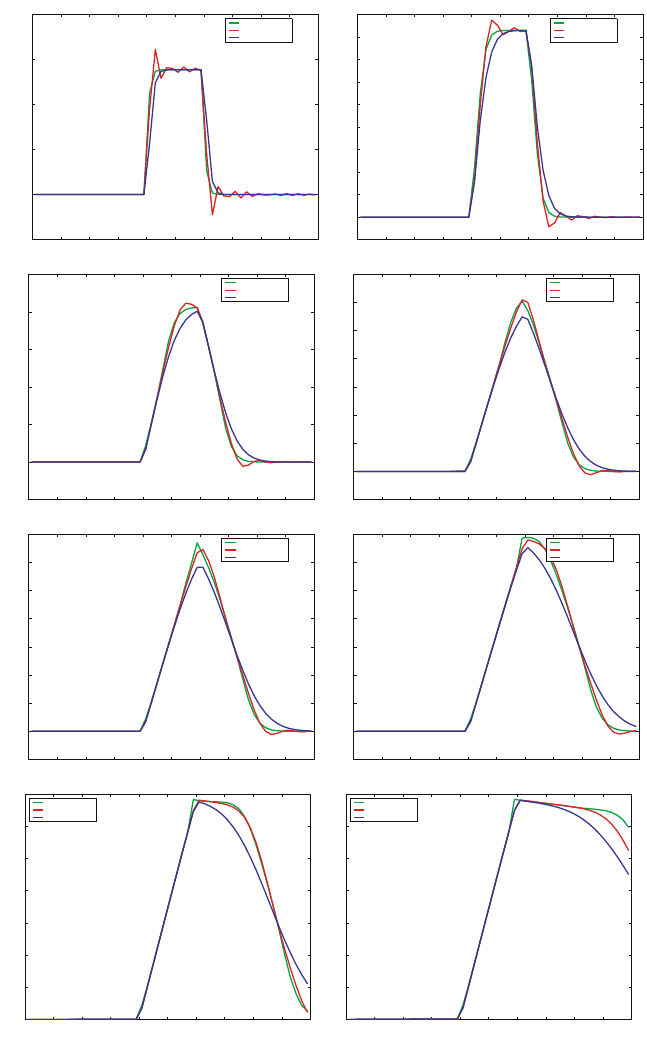
412 B.L. Bihari and P.N. Brown
0 0 1 0 2 0 3 0 4 0 5 0 6 0 7 0 8 0 9 1
0 05
0
0 05
0 1
0 15
0 2
Time = 1e 08
x (cm)
φ (n/cm
2
−s)
WENO3
Petrov Galerkin
Upwind
0 0 1 0 2 0 3 0 4 0 5 0 6 0 7 0 8 0 9 1
0 1
0
0 1
0 2
0 3
0 4
0 5
0 6
0 7
0 8
0 9
x (cm)
φ (n/cm
2
−s)
Time = 6e 08
WENO3
Petrov Galerkin
Upwind
0 0 1 0 2 0 3 0 4 0 5 0 6 0 7 0 8 0 9 1
0 5
0
0 5
1
1 5
2
2 5
T me = 1 5e 07
x (cm)
φ (n/cm
2
−s)
WENO3
Petrov Galerkin
Upwind
0 0 1 0 2 0 3 0 4 0 5 0 6 0 7 0 8 0 9 1
0 5
0
0 5
1
1 5
2
2 5
3
3 5
Time = 2 3e 07
x (cm)
φ (n/cm
2
−s)
WENO3
Petrov Galerk n
Upwind
0 0 1 0 2 0 3 0 4 0 5 0 6 0 7 0 8 0 9 1
0 5
0
0 5
1
1 5
2
2 5
3
3 5
T me = 2 6e 07
x (cm)
φ (n/cm
2
−s)
WENO3
Petrov Galerkin
Upwind
0 0 1 0 2 0 3 0 4 0 5 0 6 0 7 0 8 0 9 1
0 5
0
0 5
1
1 5
2
2 5
3
3 5
x (cm)
φ (n/cm
2
−s)
Time = 3 5e 07
WENO3
Petrov Galerk n
Upwind
0 0 1 0 2 0 3 0 4 0 5 0 6 0 7 0 8 0 9 1
0
0 5
1
1 5
2
2 5
3
3 5
T me = 4 7e 07
x (cm)
φ (n/cm
2
−s)
WENO3
Petrov Ga erkin
Upw nd
0 0 1 0 2 0 3 0 4 0 5 0 6 0 7 0 8 0 9 1
0
0 5
1
1 5
2
2 5
3
3 5
x (cm)
φ (n/cm
2
−s)
Time = 7 4e 07
WENO3
Petrov Galerkin
Upwind
Fig. 1. Comparison of the WENO, P-G, and UW methods at different times (µ>0)
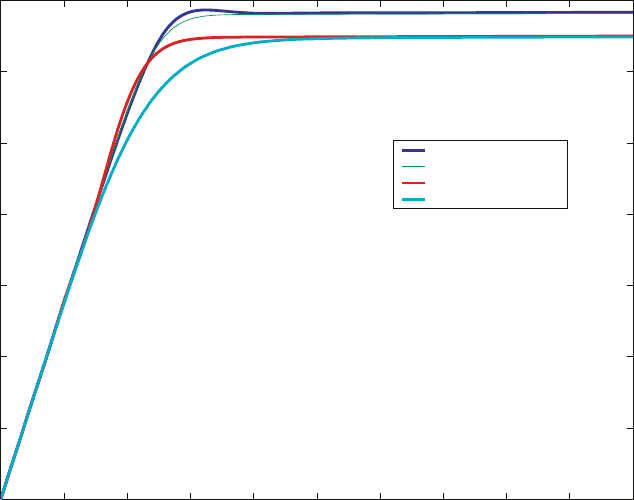
High Order Schemes for BTE 413
0 0.1 0.2 0.3 0.4 0.5 0.6 0.7 0.8 0.9 1
x 10
−6
0
0.5
1
1.5
2
2.5
3
3.5
Time−plot at x=0.6 for WENO3, PG and UW on 50 cells, UW on 1000 cells
WENO3 scheme
Upwind−−1000 cells
Petrov−Galerkin
Upwind
Fig. 2. Time evolution of the solution at x =0.6
(3) Thin/thick materials, large unsteady source. Wenowtestthecodeona
two-material problem defined by:
σ(x)=
0.0001, if x ∈ [0, 0.1]
100, otherwise
σ
s
=0
and the source, localized by x ∈ [0, 0.1], changes in time as:
q(t)=
8 × 10
12
, if t ∈ [10
−9
, 4 × 10
−9
]
0, otherwise
The suite of methods tested now includes not just WENO3 and WENO5,
upwind, and P-G, but the Simple Corner Balance (SCB) [Ad97] and the
Diamond-Difference with negative flux fix-up (D-D) [LM93] methods as well;
both of the latter are cell-centered schemes. We compare all these methods
on a grid of M = 200 cells with a very fine grid upwind solution on 5000
cells. The latter is again guaranteed to converge to the right solution under
grid refinement.
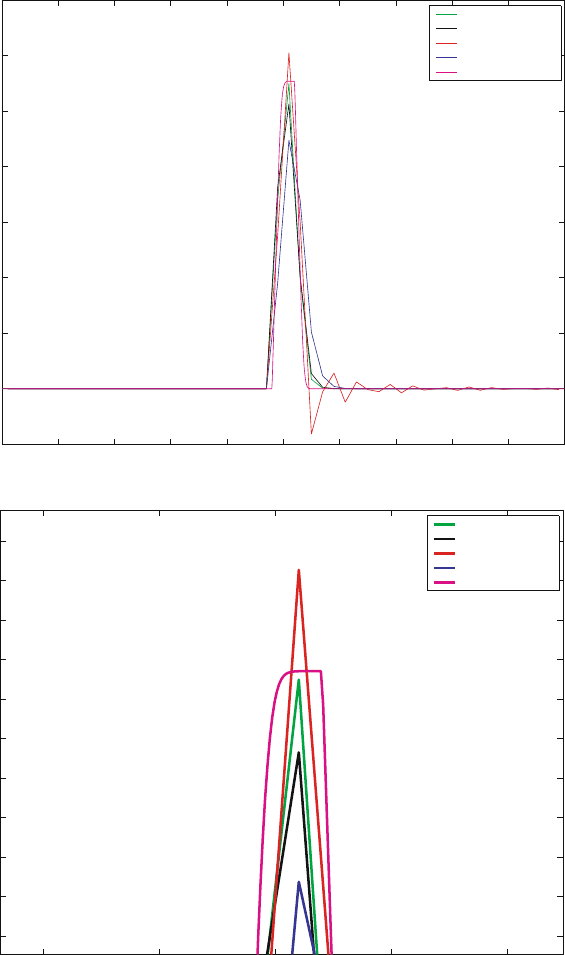
414 B.L. Bihari and P.N. Brown
0 0.1 0.2 0.3 0.4 0.5 0.6 0.7 0.8 0.9 1
−0.05
0
0.05
0.1
0.15
0.2
0.25
0.3
0.35
x (cm)
φ (n/cm
2
−s)
Time = 2e−08
WENO5
WENO3
Petrov−Galerkin
Upwind
UW−fine
0.4 0.45 0.5 0.55 0.6
0.21
0.22
0.23
0.24
0.25
0.26
0.27
0.28
0.29
0.3
0.31
x (cm)
φ (n/cm
2
−s)
Time = 2e−08
WENO5
WENO3
Petrov−Galerkin
Upwind
UW−fine
Fig. 3. Comparison of the WENO, P-G, and upwind (coarse and fine grid) methods
for µ>0att =2× 10
−8
(bottom fig.is close-up)
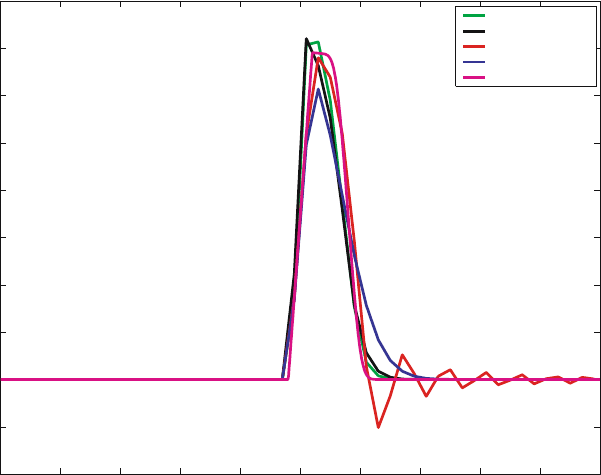
High Order Schemes for BTE 415
0 0.1 0.2 0.3 0.4 0.5 0.6 0.7 0.8 0.9 1
−0.2
−0.1
0
0.1
0.2
0.3
0.4
0.5
0.6
0.7
0.8
x (cm)
φ (n/cm
2
−s)
Time = 1e−07
WENO5
WENO3
Petrov−Galerkin
Upwind
UW−fine
Fig. 4. Comparison of the WENO, P-G, and upwind (coarse and fine grid) methods
for µ>0att =10
−7
An examination of Fig. 5 reveals the two salient features of the WENO
scheme: (i) its nonoscillatory nature and (ii) high order of accuracy in smooth
regions. The latter property is more pronounced when the solution has areas
of smooth variation. In Fig. 5 we show close-ups of the highly varying regions
on the right side of each snapshot. These confirm our expectation of the
WENO scheme coming very close to the superfine solution, while the lower
order schemes produce large errors near extrema and/or oscillations near
steep gradients. To avoid having to include a large number of plots, we chose
to use the integrated quantity φ in Fig. 5.
(4) Thick/thin materials, large unsteady source. If we reverse the two material
properties, but leave the source term as in Case (3), we can test the code on
a “thick-to-thin” problem. Thus set:
σ(x)=
100, if x ∈ [0, 0.1]
0.0001. otherwise
σ
s
=0
In this case the high order of accuracy offered by the WENO method is
quite pronounced near the corner regions of the profiles. The WENO3 and
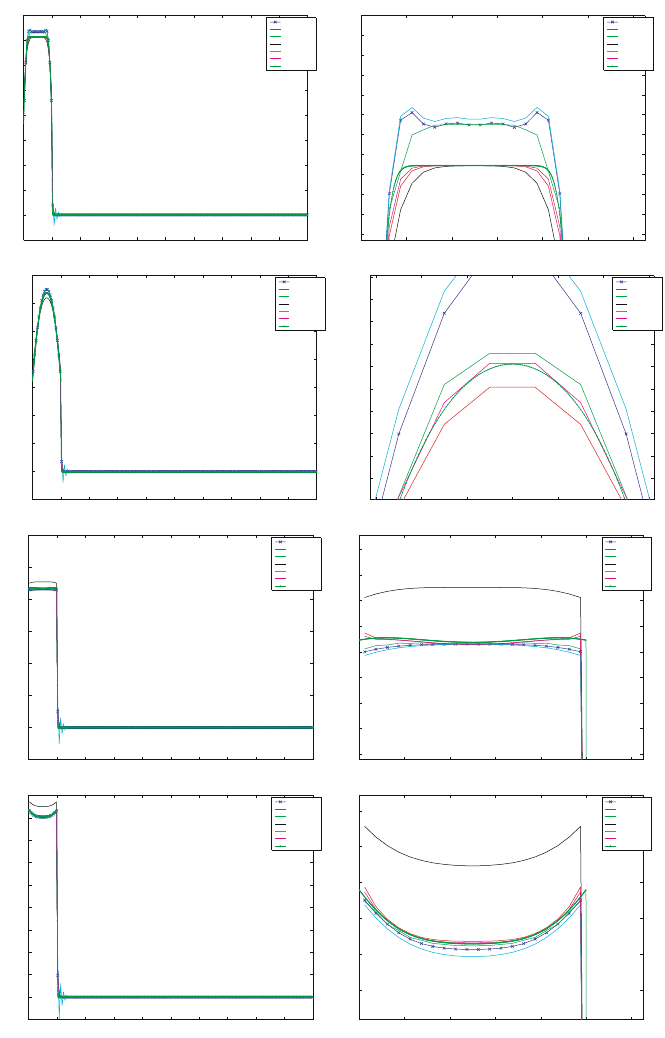
416 B.L. Bihari and P.N. Brown
0 1 2 3 4 5 6 7 8 9 10
2
0
2
4
6
8
10
12
14
16
x 10
−3
x (cm)
Φ (neutrons/cm
2
)
Plot of Φ for snapshot 1
D D
WENO3
SCB
UPW
P G
WENO5
UPW fine
0 0 2 0 4 0 6 0 8 1 1 2
0 0136
0 0138
0 014
0 0142
0 0144
0 0146
0 0148
0 015
0 0152
0 0154
0 0156
x (cm)
Φ (neutrons/cm
2
)
Plot of Φ for snapshot 1
D D
WENO3
SCB
UPW
P G
WENO5
UPW fine
0 1 2 3 4 5 6 7 8 9 10
0 02
0
0 02
0 04
0 06
0 08
0 1
0 12
0 14
x (cm)
Φ (neutrons/cm
2
)
Plot of Φ for snapshot 3
D D
WENO3
SCB
UPW
P G
WENO5
UPW f ne
0 35 0 4 0 45 0 5 0 55 0 6 0 65
0 125
0 1255
0 126
0 1265
0 127
0 1275
0 128
0 1285
0 129
0 1295
x (cm)
Φ (neutrons/cm
2
)
Plot of Φ or snapshot 3
D D
WENO3
SCB
UPW
P G
WENO5
UPW fine
0 1 2 3 4 5 6 7 8 9 10
0 2
0
0 2
0 4
0 6
0 8
1
1 2
x (cm)
Φ (neutrons/cm
2
)
Plot of Φ for snapshot 16
D D
WENO3
SCB
UPW
P G
WENO5
UPW f ne
0 0 2 0 4 0 6 0 8 1 1 2
0 78
0 8
0 82
0 84
0 86
0 88
0 9
0 92
0 94
x (cm)
Φ (neutrons/cm
2
)
Plot of Φ for snapshot 16
D D
WENO3
SCB
UPW
P G
WENO5
UPW fine
0 1 2 3 4 5 6 7 8 9 10
0 1
0
0 1
0 2
0 3
0 4
0 5
0 6
0 7
0 8
0 9
x (cm)
Φ (neutrons/cm
2
)
Plot of Φ for snapshot 32
D D
WENO3
SCB
UPW
P G
WENO5
UPW f ne
0 0 2 0 4 0 6 0 8 1 1 2
0 78
0 8
0 82
0 84
0 86
0 88
x (cm)
Φ (neutrons/cm
2
)
Plot of Φ for snapshot 32
D D
WENO3
SCB
UPW
P G
WENO5
UPW fine
Fig. 5. WENO, P-G, SCB, UW, and fine-grid UW for thin-to-thick problem
